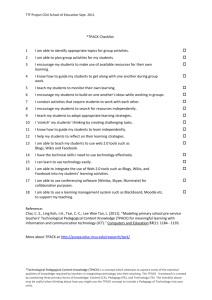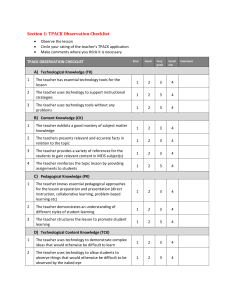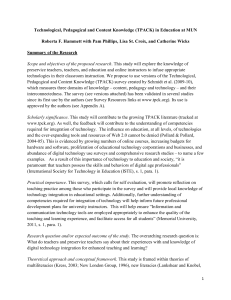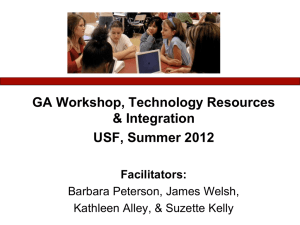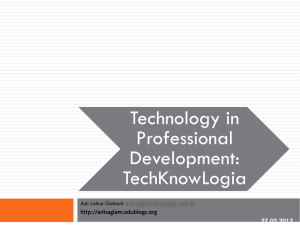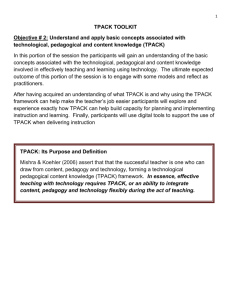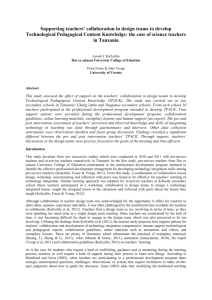TPACK development in teacher design teams: Assessing the
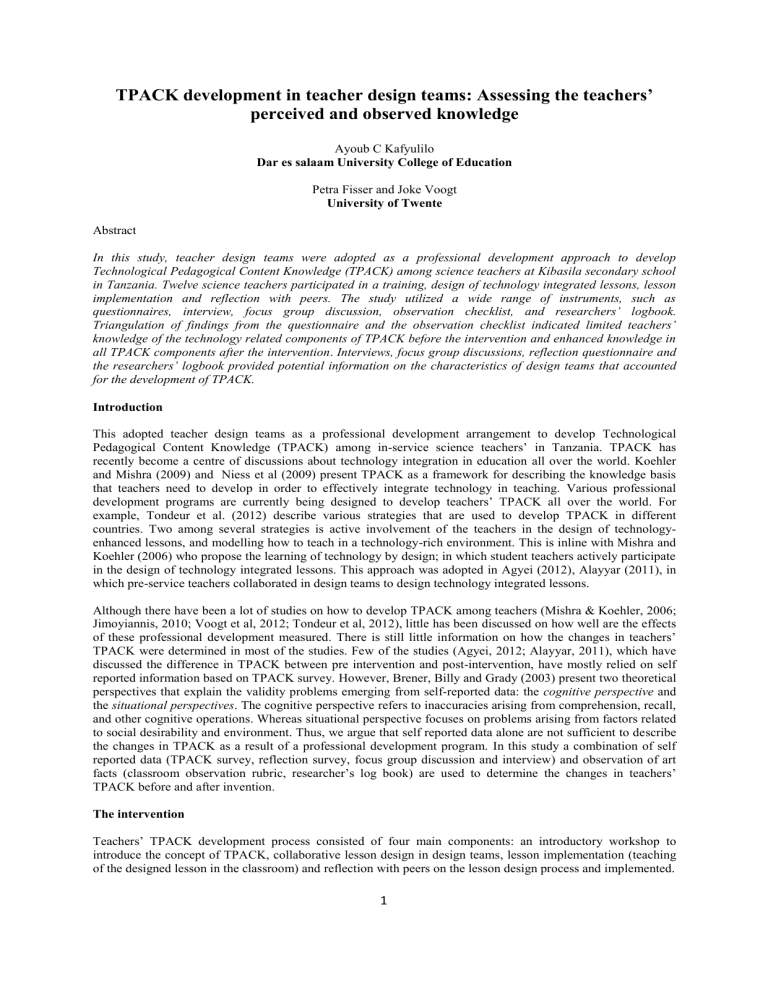
TPACK development in teacher design teams: Assessing the teachers’ perceived and observed knowledge
Ayoub C Kafyulilo
Dar es salaam University College of Education
Petra Fisser and Joke Voogt
University of Twente
Abstract
In this study, teacher design teams were adopted as a professional development approach to develop
Technological Pedagogical Content Knowledge (TPACK) among science teachers at Kibasila secondary school in Tanzania. Twelve science teachers participated in a training, design of technology integrated lessons, lesson implementation and reflection with peers. The study utilized a wide range of instruments, such as questionnaires, interview, focus group discussion, observation checklist, and researchers’ logbook.
Triangulation of findings from the questionnaire and the observation checklist indicated limited teachers’ knowledge of the technology related components of TPACK before the intervention and enhanced knowledge in all TPACK components after the intervention .
Interviews, focus group discussions, reflection questionnaire and the researchers’ logbook provided potential information on the characteristics of design teams that accounted for the development of TPACK.
Introduction
This adopted teacher design teams as a professional development arrangement to develop Technological
Pedagogical Content Knowledge (TPACK) among in-service science teachers’ in Tanzania. TPACK has recently become a centre of discussions about technology integration in education all over the world. Koehler and Mishra (2009) and Niess et al (2009) present TPACK as a framework for describing the knowledge basis that teachers need to develop in order to effectively integrate technology in teaching. Various professional development programs are currently being designed to develop teachers’ TPACK all over the world. For example, Tondeur et al. (2012) describe various strategies that are used to develop TPACK in different countries. Two among several strategies is active involvement of the teachers in the design of technologyenhanced lessons, and modelling how to teach in a technology-rich environment. This is inline with Mishra and
Koehler (2006) who propose the learning of technology by design; in which student teachers actively participate in the design of technology integrated lessons. This approach was adopted in Agyei (2012), Alayyar (2011), in which pre-service teachers collaborated in design teams to design technology integrated lessons.
Although there have been a lot of studies on how to develop TPACK among teachers (Mishra & Koehler, 2006;
Jimoyiannis, 2010; Voogt et al, 2012; Tondeur et al, 2012), little has been discussed on how well are the effects of these professional development measured. There is still little information on how the changes in teachers’
TPACK were determined in most of the studies. Few of the studies (Agyei, 2012; Alayyar, 2011), which have discussed the difference in TPACK between pre intervention and post-intervention, have mostly relied on self reported information based on TPACK survey. However, Brener, Billy and Grady (2003) present two theoretical perspectives that explain the validity problems emerging from self-reported data: the cognitive perspective and the situational perspectives . The cognitive perspective refers to inaccuracies arising from comprehension, recall, and other cognitive operations. Whereas situational perspective focuses on problems arising from factors related to social desirability and environment. Thus, we argue that self reported data alone are not sufficient to describe the changes in TPACK as a result of a professional development program. In this study a combination of self reported data (TPACK survey, reflection survey, focus group discussion and interview) and observation of art facts (classroom observation rubric, researcher’s log book) are used to determine the changes in teachers’
TPACK before and after invention.
The intervention
Teachers’ TPACK development process consisted of four main components: an introductory workshop to introduce the concept of TPACK, collaborative lesson design in design teams, lesson implementation (teaching of the designed lesson in the classroom) and reflection with peers on the lesson design process and implemented.
1
Research questions
The main research question in this study is what is the impact of teacher design teams on the teachers’ development of TPACK?
This main research question is answered by dividing it into two sub questions:
1.
What is the in-service teachers’ perceived TPACK before and after working in teacher design teams?
2.
What are the observed in-service teachers’ TPACK before and after working in teacher design teams?
Participants
The study involved 12 in-service teachers who teach science subjects (Physics, Chemistry and Biology at
Kibasila secondary school in Tanzania. Of the 12 teachers, only 3 teachers; 2 in physics and 1 in chemistry, were able to use computers with minimum difficulties. There was no teacher from the biology team who had experience with computer. These teachers teamed up according to the subjects they teach to make three teams: biology, chemistry and physics team, each with four members.
Instruments
Six data collection instruments were used in this study: TPACK survey, teacher design team (TDT) reflection survey, interview, a focus group discussion, researcher’s log book and observation checklist. The overview of the instruments and the research questions is presented in Table 1.
Table 1 Overview of data collection instruments and research questions
Data Collection Instruments
Research Questions
TPAC
K survey
Researche r’s log book
Observati on rubric
Reflecti on survey
Inter view
FGD
1.
What is in-service teachers’ perceived TPACK before and after intervention?
2.
What are the observed in-service teachers’ technology integration practices before and after intervention?
√
√ √
√ √ √
TPACK survey
The TPACK survey was adopted from Schmidt et al (2009) and Graham et al (2009), and used a 5 points Likert scale: 1 = strongly disagree, 2 = disagree, 3 = neutral, 4 = agree, 5 = strongly agree. The instrument’s reliability was 0.93 Cronbach’s alpha. Examples of items are presented in Table 2.
Table 2 Summary of the items and reliability in the TPACK survey instrument
Compone nts
Exemplary item
No. of items
Cronbach’ s α
9
10
0.80
0.94
TK
PK
CK
PCK
TCK
TPK
TPCK
I can use technology without problems
I can use a wide range of teaching approaches in a classroom setting
I know about a lot of different approaches to solve biology/physics/chemistry problems
I know how to select effective teaching approaches to guide students thinking and learning in biology/physics/chemistry
I can choose technology that enhances the content for a lesson I teach
* I can use technologies to improve my teaching productivity
I can teach a lesson that combine science, technology and teaching approaches
* Modified from Graham et al (2009)
5
7
9
11
16
0.85
0.97
0.94
0.88
0.97
2
Observation checklist
Items in the observation checklist were modified from Graham et al. (2009), Harris, Grandgenett & Hofer (2010) and Tilya (2003) and had a 3 points Likert scale: 1 = no, 2 = no/yes, 3 = yes. The observation checklist was rated by the researcher and an expert in ICT integration from the University of Dar es salaam. Table 3 presents the summary of the observation tool and the reliability in Cohen Kappa.
Table 3 Summary of items and inter-rater reliability for the observation checklist
Compo nents
Exemplary item
No. of items
Cohen’s
Kappa
TK
PK
PCK
TCK
TPK
TPCK
*Technology selections are exemplary, given curriculum goal(s) and instructional strategies.
**Teacher encourages learners to solve problems in their group discussions
**Teacher guides students learning in order to get to the core of the content
***Teacher uses technology to allow students to observe things that would otherwise be difficult to observe
***Teacher uses technology to interact and collaborate with students in the classroom
** Teacher select and use technology applications to improve students’ learning in the lesson he teaches
8
7
5
5
5
5
0.75
0.74
0.86
0.67
0.69
0.67
* Harris et al. (2010), ** Tilya (2003), *** Graham et al (2009)
Researcher’s Log Book
The researchers’ log book was used to maintain a record of activities and events occurring during the intervention process, which could not be recorded by using observation checklist. Thus, researcher’s log book was used during peer appraisal, TPACK training and lesson design. Data collected through this method were important in describing the interventions processes.
Reflection questionnaire
The reflection questionnaire was administered at the end of the intervention to assess the teachers’ experience with the learning of TPACK in teacher design teams. This questionnaire was developed by the researcher and used a 5 points Likert scale: 1 = strongly disagree, 2 = disagree, 3 = neutral, 4 = agree, 5 = strongly agree.
Examples of items in the reflection questionnaire are; (1) working in a team helped me to enhance my technological knowledge (2) Working in team has helped me to understand more about technology integration in science teaching. The overall reliability for items related to TPACK alone was 0.68 Cronbach’s alpha.
Teacher interview
Pre-intervention interview questions were adopted from Landry (2010) and intended to assess teachers’ perception towards the use of technology in science teaching. Examples of questions were: (1) what technology is available at your school for use in science teaching? (2) How are you using the available technology in teaching? Post-intervention interview questions were adopted from Handelzalts (2009) and Tilya (2003) to assess teachers’ experience on learning TPACK in design teams. An example of a question that was asked in this interview was: What technology integration knowledge and skills did you develop through collaboration in design teams? Two people including the researcher coded a randomly selected sample of 4 interviews out of 12 and the inter-coder reliability was 0.83 Cohen Kappa.
Focus group discussion
A focus group discussion was administered at the end of the intervention to assess teachers’ opinions about teacher design teams as a professional development arrangement to develop TPACK. Some of the questions for focus group discussion were adopted from Handelzalts (2009), others were developed by the researcher.
Example of questions asked during the focus group discussion includes: what technology integration competencies did you develop in design teams? Again, two people including the researcher coded a randomly selected focus group discussion out of the three and the inter-coder reliability was 0.92 Cohen Kappa.
Findings
3
Teachers’ perceived TPACK before and after the intervention
Before intervention, in-service science teachers perceived their CK, PK and PCK as high, whereas TK, TCK,
TPK and TPCK were perceived low. After the intervention, they perceived their knowledge in all TPACK components as high. A Wilcoxon signed ranks test for two related samples was used to determine whether or not there was a significant difference between pre and post intervnetion results. Results showed a significant deference at p ≤ 0.01 for technology related components, and p ≤ 0.05 for Content Knowledge and Pedagogical
Content Knowledge (Table 4).
Table 4 Perceived TPACK before and after the intervnetion (N = 12)
TPACK components
Technological Knowledge
Pedagogical Knowledge
Content Knowledge
Pedagogical Content Knowledge
Technological Pedagogical Knowledge
Technological Content Knowledge
Technological Pedagogical Content Knowledge
Pre-intervention
M (SD)
3.13 (0.43)
3.98 (0.69)
4.00 (0.56)
3.82 (0.66)
3.14 (0.59)
2.85 (0.67)
2.97 (0.83)
Post-intervention
M (SD)
4.18 (0.42)
4.63 (0.39)
4.40 (0.61)
4.40 (0.61)
4.23 (0.58)
4.30 (0.56)
4.27 (0.55)
Z-score Sig.
-3.061 0.002
-2.944 0.003
-2.105 0.035
-2.320 0.020
-3.062 0.002
-3.065 0.002
-3.061 0.002
Scale: 1 = strongly disagree, 2 = disagree, 3 = undecided, 4 = agree and 5 = strongly agree.
The fidings reported in Table 4 are justified by those in Table 5, where majority of teachers strongly agree to have learned various TPACK components in teacher design teams.
Table 5 Perceived impact of collaboration in design teams on the development of TPACK compon ents
Items Mean SD
CK
TK
I improved my lesson design through working in team
Working in a design team helped me to enhance my technological knowledge
4.75 0.452
4.92 0.289
PK Working in a design team helped me to enhance my pedagogical knowledge working in team has helped me to understand more about technology integration in
4.83 0.389
TCK science teaching
4.75 0.500
TPCK I think I can improve my technology integration capability when I work in a design team 4.83 0.389
TPCK
Through discussion in a design team I learned how technology pedagogy and content are integrated in practice
4.92 0.289
Scale: 1 = strongly disagree, 2 = disagree, 3 = undecided, 4 = agree and 5 = strongly agree.
In addition to Table 5 which indicates a high level of agreement about the learning opportunity offered through design teams, results from the pre-intervention interview showed that teachers were not using the available computers at the school for teaching, rather they used for administration purposes (typing letters, preparing students tests and keeping students’ records). Post intervention interview and focus group discussion (Table 6) further describe the specific components of TPACK that teachers perceived to have developed through collaboration in design teams.
Table 6 Specific components of TPACK that were learned through design teams as revealed from interview
Category Responses Frequency %
TK
PK
CK
Use of PowerPoint to design slides
To make animations by using PowerPoint
Making a diagram by using a computer
To record a video by using a digital camera
To download youtube video
Use of learner centered teaching approaches
Systematic planning of students learning activities
Some physics topics
67
50
16
16
8.3
42
16
8.3
4
TCK
TPK
Use of power point to present a lesson
To present a lesson by using a computer
Planning of technology based students activities
The integration of students’practical work and technology
Use of video for teaching
Application of computer in the teaching and learning
33
25
33
25
16
8.3
TPACK Use of technology to demonstrate practical activities in science 8.3
As indicated in Table 6, teachers reported that through collaboration they developed knowledge and skills of almost all TPACK components except the PCK which was already common to them.
Observed teachers’ TPACK before and after intervention
Prior to the intervention, teachers were asked to prepare a lesson that integrate technology and teach in a classroom. Two teachers from each team prepared a 40 minutes lesson and taught in the classroom. Some of the observed teachers used teaching aids, such as biological models, chart (e.g. human skeleton) and some test apparatus (beaker, test tubes), and some of the teachers did not have any aid, other than the notes book and chalks. No ICT was used during the pre-intervention phase. However, in the post intervention teaching, all teachers used ICT to support students’ learning. The post intervention session also had an improved pedagogy where students’ participation in learning was enhanced. There were four lessons for each team (two before intervention and the other two after intervention). Thus, a total of twelve lessons for all three teams, six before intervention and six after intervention. Teachers’ TPACK before and after intervention was determined through observation checklist and the results are presented in Table 7
Table 7 Observed teaching with technology, before and after the intervention (N =6)
TPACK components
Technology Knowledge
Pedagogical Knowledge
Pedagogical Content Knowledge
Technological Content Knoweldge
Technological Pedagogical Knowledge
Technological Pedagogical Content Knowledge
Pre intervention
M (SD)
1.17 (0.17)
2.19 (0.08)
2.43 (0.08)
1.20 (0.15)
1.20 (0.15)
1.40 (0.11)
Post intervention
M (SD)
2.60 (0.23)
2.79 (0.35)
2.83 (0.34)
2.83 (0.40)
2.63 (0.31)
2.70 (0.25)
Z- score Sig.
-2.201 0.028
-2.226 0.026
-2.032 0.042
-2.214 0.027
-2.214 0.027
-2.214 0.027
These findings are reported in a three points Likert scale where 1 = No, 2 = Yes/No, 3 = Yes.
As it was for self-reported results, observation results also showed a low teachers’ Technological Knowledge,
Technological Content Knowledge, Technological Pedagogical Knowledge and Technological Pedagogical
Content Knowledge, which were all having means below the average.
Conclusions and discussions
Findings have shown an interelatedness between data collected through TPACK survey and those of observation checklist. From TPACK survey it has been revelead that before intervention, teachers had perceived their knoweldge on technology related components to be more limited compared to the knoweldge of pedagogy, content and pedagogical content. Similarly, in the observation results, teachers’ technology related components of TPACK were rated low during the pre-intervention assessment. However, both post intervention perceived and observed results were significantly high during the post-intervention assessment. Pre and post intervention results indicate an agreement between teachers’ perceived and observed TPACK. This is different from the findings of Allayar (2011) which indicated a difference between self reported and observed data. However, in this case, the use of logbook was found important in noting down some important features of technology integration that could not be observed through the observation checklist. The logbook provided a summary of the difficulties that teachers were experiencing during the lesson preparation process and classroom teaching, thus providing the basis for improvement of the teachers’ training on the use of technology.
Although interview and focus group discussion represents a self reported data, the opportunity to probe for more information from the respondent, makes them different from survey tools. Through probes, teachers were able to provide some detailed inforamtion regarding the specific TPACK competencies they developed through
5
collabroative lesson design in teacher design teams. This enabled the researcher to identify specific TK, PK, CK,
TPK, TCK and TPACK that teachers were able to develop through collaboration in design team (see Table 6).
Focus group discussion on the other hand, acted as a room for discussion among teachers themselves and between teachers and the researcher. In the focus group discusion teachers were able to propose an idea and agree amongst themselves as to whether the idea is a representation of a team’s opinion or not. This was important in informing the researcher about the specific skills and knowledge that the whole team developed from the professional development program.
For the purpose of understanding whether or not the professional development had any added value to the teachers’ learning of TPACK, the use of reflection questionnaire was considered potential. The findings from this study lead us to a conclusion that, in order to have a more comprehensive information of what technology integration knowledge and skills teachers develop from the professional development program, a combination of self reported (questionnaire, interview, focus group discusion) and observation (checklist, artfacts and logbooks) should be used.
Reference
Agyei, D. (2012). Preparation of pre-service teachers in Ghana to integrate Information and Communication
Technology in teaching mathematics.
Doctoral Dissertation, Enschede: University of Twente.
Alayyar, G. (2011). Developing pre-service teacher competencies for ICT integration through design teams.
Doctoral Dissertation, Enschede: University of Twente.
Brener, N.D., Billy, J.O.G., & Grady, W.R. (2003). Assessment of factors affecting the validity of selfreported health-risk behavior among adolescents: evidence from the scientific literature, Journal of Adolescent
Health, (33), 436–457
Jimoyiannis, A. (2010). Designing and implementing an integrated technological pedagogical science knowledge framework for science teachers’ professional development. Computers & Education, doi:10.1016/j.compedu.2010.05.022
Graham, C.R., Burgoyne, N., Cantrell, P., Smith, L., Clair, L. & Harris, R. (2009). TPACK development in science teaching: Measuring the TPACK confidence of inservice science teachers. TechTrends, 53 (5),
70-79.
Handelzalts, A. (2009). Collaborative curriculum development in teacher design team . Doctoral Dissertation.
Enschede: University of Twente.
Harris, J., Grandgenett, N. & Hofer, M. (2010). Testing a TPACK-based technology integration assessment rubric. In D. Gibson & B. Dodge (Eds.), Proceedings of Society for InformationTechnology & Teacher
Education International Conference 2010 (pp. 3833-3840). Chesapeake, VA: AACE.
Koehler, M., & Mishra, P. (2009). What is Technological Pedagogical Content Knowledge? Contemporary
Issues in Technology and Teacher Education , 9 (1), 60-70.
Landry, G.A. (2010) Creating and Validating an Instrument to Measure Middle School Mathematics Teachers’
Technological Pedagogical Content Knowledge (TPACK).
PhD dissertation, Tennessee: University of
Tennessee.
Mishra, P., & Koehler, M. (2006). Technological Pedagogical Content Knowledge: A framework for teacher knowledge. Teachers College Record, 108 (6), 1017–1054.
Niess, M. L., Ronau, R. N., Shafer, K. G., Driskell, S. O., Harper S. R., Johnston, C., Browning, C., Özgün-
Koca, S. A., & Kersaint, G. (2009). Mathematics teacher TPACK standards and development model.
C ontemporary Issues in Technology and Teacher Education , 9 (1), 4-24.
Schmidt, D., Baran, E., Thompson, A., Koehler, M.J., Mishra, P., & Shin, T. (2009, March). Examining preservice teachers’ development of technological pedagogical content knowledge in an introductory instructional technology course. Paper presented at the 2009 International Conference of the Society for the Information and Technology & Teacher Education. Charleston: South Carolina.
Tilya, F. (2003). Teacher support for the use of MBL in activity-based physics teaching in Tanzania. Doctoral dissertation, Enschede: University of Twente.
Tondeur, J., van Braak, J., Sang, G., Voogt, J., Fisser, P., & Ottenbreit-Leftwich, A. (2012). Preparing preservice teachers to integrate technology in education: A synthesisof qualitative evidence. Computers &
Education, (59), 134–144.
Voogt, J., Fisser, P., Pareja Roblin, N., Tondeur, J., & van Braak, J. (2012) Technological pedagogical content knowledge – a review of the literature, Journal of Computer Assisted Learning, doi: 10.1111/j.1365-
2729.2012.00487.x.
87 1
6
